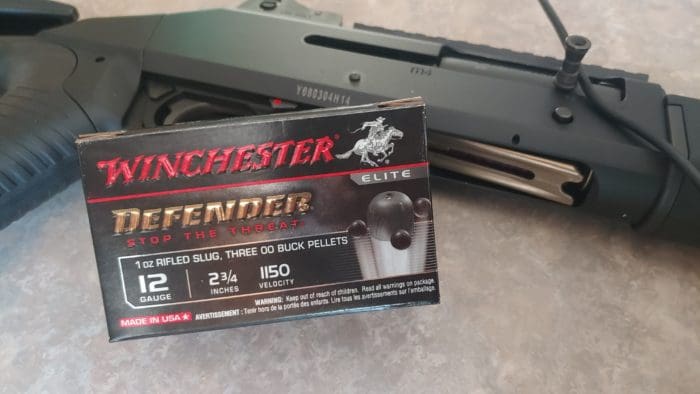Buck and ball loads have a pretty long history of success in the United States. However, that success was primarily from 1776 to the 1860s. New buck and ball loads haven’t been quite as popular since the invention of modern shotshells and cartridge ammunition.
Several years ago, Winchester introduced the PDX1 Defender load, which introduced us to the first mass produced buck and ball load offered in decades.
The PDX1 load (which Winchester seems to be calling just Defender these days) is a bit different than the buck and ball load from way back when. This is a 1-ounce slug with three 00 buckshot pellets packed in the shell. The pellets are plated, and I’d imagine its a must-have to prevent deformation when fired with the slug behind them.
The idea and purpose behind the round is to improve your chances of hitting your target at increased ranges. Throwing four projectiles instead of one seems to be an excellent way to catch at least part of your target at longer ranges, and in theory it should work.
This is a difficult review because I’m judging the round on its performance, but also it’s overall usefulness. If usefulness and performance were on the same graph, they’d be a good way apart with the PDX1 slugs.
What Works about the PDX1
The PDX1 slugs are quite accurate when fired from a smooth bore with a cylinder choke. I used a Benelli M4 and a Mossberg 590A1 for my tests. Both guns are equipped with ghost ring sights and allow precise slug shots. At various ranges, the slug hit right where I wanted it and grouped well.
At about 50 yards, I kept them placed perfectly in my 10-inch gong and scored a few hits as far out as 75 yards on the same target.
At 25 yards, I attempted some snap fire headshots from the low ready with the Benelli and landed two out of three rounds and dropped the third pretty severely. That was entirely my fault, I was chasing speed and forgetting that accuracy matters more.
Accuracy is excellent for the actual slugs.
The slugs are moving at 1,150 feet per second. They are low recoiling rounds and very controllable in both pump-action and semi-auto shotguns.
I purchased and fired twenty rounds of the PDX1 and every single round cycled without issue. I fired ten in each gun and never ran into a malfunction. It’s a small sample size, but the ammo seems to be reliable and cycles well in semi-autos.
I purchased two ten-round boxes for 13 bucks each. That’s a pretty good price for defensive slugs as far as I’m concerned.
The PDX1 Defender slugs have a lot going for them in some ways. They are accurate, reliable, and affordable.
The Downsides
The additional buckshot to our buck and ball load is the biggest downside. If I were in a firing line facing approaching English red coats, then buck and ball loads make a lot of sense.
If I’m using a slug to place an accurate and precise shot with a shotgun outside of normal shotgun distances, then the buck creates problems.
Look at this poor Q target. It took a round from 15 yards, 25 yards, and fifty yards. You can count three slug holes, but only six buckshot holes. Where are the other three pellets?
Here is the first shot at 15 yards. One pellet completely missed the Q target and hit the border. This would be unaccounted for in a real defensive shooting.
Where are the other pellets for the 25 and 50-yard shots? They went into the ether. If this had been a defensive shooting, those pellets could wound a person or cause property damage. Or both.
Here is a headshot at 25 yards, which is a near miss, and for one pellet of buckshot, it is a total miss.
Those three pellets of buckshot might make it easy to hit your target, but they also make it easy for some of them to miss. Their spread seems to be unpredictable, and patterning the PDX1 load isn’t feasible.
Who is the PDX1 for?
If you used the round at home defense ranges, you aren’t likely to have a thrown pellet. None were thrown at 10 yards and closer. However, this does mean you need a perfect squared up shot. Lord forbid you have to take a shot at someone at a different than optimum angle.
For law enforcement, I can’t see a reason for the load. If you are taking a precise slug shot, you are likely 15 yards and beyond and don’t want random buckshot pellets flying around.
The only real use I can see is for invading Fallujah (or other battlegrounds) where errant pellets would be less of an issue.
I appreciate the PDX1’s performance, but it’s not a round I have a real use for.
Specifications: Winchester PDX1 Defender
Caliber: 12 Gauge
Shot Type: 1-ounce slug three 00 pellets
Shell Lenght: 2 3/4
Price: $13 to $17 a box
Ratings (out of five stars):
Accuracy * *
The slugs hit the target, but the buckshot is unpredictable from about 15 yards and further. Slugs are meant to be used beyond buckshot’s range.
Reliability * * * * *
The round never failed to go bang. The length of its shell is consistent, and they shoot fine in semi-auto guns.
Shootability * * * * *
These are soft shooting slugs, and even used in pump-action shotguns, they are plenty comfortable and usable.
Overall * *
The slugs work in most ways, but the addition of the buckshot pellets really brings down their score. I can’t think of a good defensive use for them. Maybe they would be okay for hunting. The good news is Winchester makes standard PDX1 segmented rounds. Those are a much better option.
